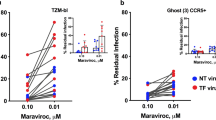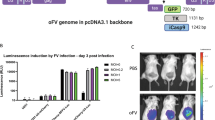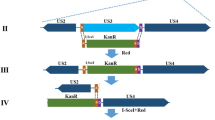Abstract
In this study, self-inactivating (SIN) retroviral vectors based on feline foamy virus (FFV) were constructed and analysed. The FFV SIN vectors were devoid of the core FFV long terminal repeat promoter plus upstream sequences but contained all structural and regulatory genes. This design allowed sensitive detection of replication-competent revertants (RCRs). The FFV SIN vectors efficiently transduced the green fluorescence protein into recipient cells. However, RCRs appeared after serial passages of transduced cells. In all RCR clones analysed, parts of the heterologous cytomegalovirus immediate early promoter, originally driving expression of the FFV vector genome, were taken up to restore the deleted SIN promoter function required for replication competence. The RCRs were strongly reduced in replication capacity compared with the parental replication-competent vectors containing the FFV promoter. In all RCR genomes analysed, the uptake of the heterologous promoter was accompanied by deletion of almost the complete marker gene. Although the RCRs described in this study may not have the capacity to spread in humans and animals, they may pose a theoretical risk, for instance during transduction of haematopoietic stem cells. Thus, FV-based SIN vectors require additional genetic modifications in order to avoid RCRs.
This is a preview of subscription content, access via your institution
Access options
Subscribe to this journal
Receive 12 print issues and online access
$259.00 per year
only $21.58 per issue
Buy this article
- Purchase on Springer Link
- Instant access to full article PDF
Prices may be subject to local taxes which are calculated during checkout





Similar content being viewed by others
References
Kay MA, Glorioso JC, Naldini L . Viral vectors for gene therapy: the art of turning infectious agents into vehicles of therapeutics. Nat Med 2001; 7: 33–40.
Schnell MJ . Viral vectors as potential HIV-1 vaccines. FEMS Microbiol Lett 2001; 200: 123–129.
Chang L-J . Pest not guest. Gene Therapy 2003; 10: 193–194.
Verma IM, Somia N . Gene therapy – promises, problems and prospects. Nature 1997; 389: 239–242.
Somia N, Verma IM . Gene therapy: trials and tribulations. Nat Rev Genet 2000; 1: 91–99.
Buchschacher GL . Introduction to retroviruses and retroviral vectors. Somat Cell Mol Genet 2001; 26: 1–11.
Yu SF et al. Self-inactivating retroviral vectors designed for transfer of whole genes into mammalian cells. Proc Natl Acad Sci USA 1986; 83: 3194–3198.
Olson P, Temin HM, Dornburg R . Unusually high frequency of reconstitution of long terminal repeats in U3-minus retrovirus vectors by DNA recombination or gene conversion. J Virol 1992; 66: 1336–1343.
Reuss FU, Berdel B, Heber R, Ploss M . Enhancer-deficient amphotropic murine leukemia virus and recombinants with heterologous transcription elements can be efficiently amplified and detected in Mus dunni fibroblasts. Gene Therapy 2002; 9: 1183–1188.
Reuss FU, Berdel B, Ploss M, Heber R . Replication of enhancer-deficient amphotropic murine leukemia virus in human cells. Proc Natl Acad Sci USA 2001; 98: 10898–10903.
Yu SS et al. Construction of a retroviral vector production system with the minimum possibility of a homologous recombination. Gene Therapy 2003; 10: 706–711.
Jackson RJ et al. Expression of mouse interleukin-4 by a recombinant ectromelia virus suppresses cytolytic lymphocyte responses and overcomes genetic resistance to mousepox. J Virol 2001; 75: 1205–1210.
Meiering CD, Linial ML . Historical perspective of foamy virus epidemiology and infection. Clin Microbiol Rev 2001; 14: 165–176.
Bieniasz PD et al. Gene transfer using replication-defective human foamy virus vectors. Virology 1997; 235: 65–72.
Hill CL, Bieniasz PD, McClure MO . Properties of human foamy virus relevant to its development as a vector for gene therapy. J Gen Virol 1999; 80: 2003–2009.
Mergia A, Heinkelein M . Foamy virus vectors. Curr Top Microbiol Immunol 2003; 277: 131–159.
Bodem J, Löchelt M, Yang P, Flügel RM . Regulation of gene expression by human foamy virus and potentials of foamy viral vectors. Stem Cells 1997; 15: 141–147.
Linial M . Why aren't foamy viruses pathogenic? Trends Microbiol 2000; 8: 284–289.
Schwantes A et al. Application of chimeric feline foamy virus-based retroviral vectors for the induction of antiviral immunity in cats. J Virol 2003; 44: 7830–7842.
Vassilopoulos G, Trobridge G, Josephson NC, Russell DW . Gene transfer into murine hematopoietic stem cells with helper-free foamy virus vectors. Blood 2001; 98: 604–609.
Trobridge G, Vassilopoulos G, Josephson N, Russell DW . Gene transfer with foamy virus vectors. Methods Enzymol 2002; 346: 628–648.
Leurs C et al. Comparison of three retroviral vector systems for transduction of nonobese diabetic/severe combined immunodeficiency mice repopulating human CD34(+) cord blood cells. Hum Gene Ther 2003; 14: 509–519.
Thomas CE, Ehrhardt A, Kay MA . Progress and problems with the use of viral vectors for gene therapy. Nat Rev Genet 2003; 4: 346–358.
Trobridge G et al. Improved foamy virus vectors with minimal viral sequences. Mol Ther 2002; 6: 321–328.
Erlwein O, Bieniasz PD, McClure MO . Sequences in pol are required for transfer of human foamy virus-based vectors. J Virol 1998; 72: 5510–5516.
Heinkelein M et al. Improved primate foamy virus vectors and packaging constructs. J Virol 2002; 76: 3774–3783.
Schwantes A, Ortlepp I, Löchelt M . Construction and functional characterization of feline foamy virus-based retroviral vectors. Virology 2002; 301: 53–63.
Bodem J, Löchelt M, Delius H, Flügel RM . Detection of subgenomic cDNAs and mapping of feline foamy virus mRNAs reveals complex patterns of transcription. Virology 1998; 244: 417–426.
Löchelt M . Foamy virus transactivation and gene expression. Curr Top Microbiol Immunol 2003; 277: 27–61.
Rethwilm A . The replication strategy of foamy viruses. Curr Top Microbiol Immunol 2003; 277: 1–26.
Zemba M et al. Construction of infectious feline foamy virus genomes: cat antisera do not cross-neutralize feline foamy virus chimera with serotype-specific Env sequences. Virology 2000; 266: 150–156.
Li Z, Yang P, Liu H, Li WX . A new indicator cell line to monitor human foamy virus infection and stability in vitro. Intervirology 2002; 45: 79–84.
Schenk T, Enssle J, Fischer N, Rethwilm A . Replication of a foamy virus mutant with a constitutively active U3 promoter and deleted accessory genes. J Gen Virol 1999; 80: 1591–1598.
Boshart M et al. A very strong enhancer is located upstream of an immediate early gene of human cytomegalovirus. Cell 1985; 41: 521–530.
Reuss FU, Heber R, Ploss A, Berdel B . Amphotropic murine leukemia virus replication in human mammary epithelial cells and the formation of cytomegalovirus-promoter recombinants. Virology 2001; 291: 91–100.
Chong H, Starkey W, Vile RG . A replication-competent retrovirus arising from a split-function packaging cell line was generated by recombination events between the vector, one of the packaging constructs, and endogenous retroviral sequences. J Virol 1998; 72: 2663–2670.
Alke A et al. The bet gene of feline foamy virus is required for virus replication. Virology 2001; 287: 310–320.
Alke A et al. Characterization of the humoral immune response and virus replication in cats experimentally infected with feline foamy virus. Virology 2000; 275: 170–176.
Acknowledgements
We thank Jennifer Reed, Jürgen Kleinschmidt, Nadine Kirchner (DKFZ), and Allison German (Bristol University, UK) for critically reading the manuscript, and Harald zur Hausen for continuous support.
Author information
Authors and Affiliations
Rights and permissions
About this article
Cite this article
Bastone, P., Löchelt, M. Kinetics and characteristics of replication-competent revertants derived from self-inactivating foamy virus vectors. Gene Ther 11, 465–473 (2004). https://doi.org/10.1038/sj.gt.3302185
Received:
Accepted:
Published:
Issue Date:
DOI: https://doi.org/10.1038/sj.gt.3302185



